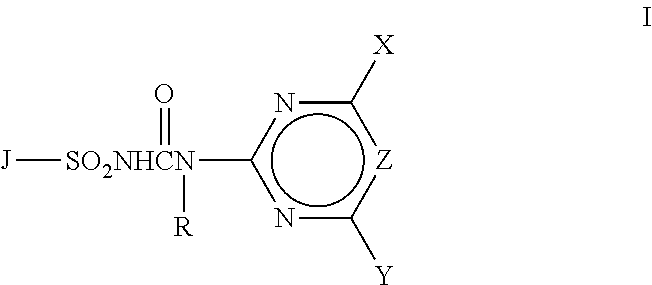Liquid sulfonylurea herbicide formulations
a technology of sulfonylurea and liquid formulation, which is applied in the field of liquid formulations of sulfonylurea herbicides, can solve the problems of difficult to obtain stable liquid formulations, prone to certain problems in liquid formulations of sulfonylureas, and affecting the level of weed control efficacy obtained
- Summary
- Abstract
- Description
- Claims
- Application Information
AI Technical Summary
Problems solved by technology
Method used
Image
Examples
formulation examples
[0317]The following Examples describe the preparation and stability testing of compositions of the present invention. Technical grade nicosulfuron and thifensulfuron-methyl were used to prepare the Example compositions; the percent active ingredient in the technical material is shown in parentheses and the weight listed refers to the weight of the technical material. The stability of the sulfonylureas in the compositions prepared in the Examples was determined by aging samples in heated ovens and then comparing the sulfonylurea content before and after aging to determine percent (%) relative decomposition. The % relative decomposition was calculated by subtracting the final weight % sulfonylurea from the initial weight % sulfonylurea, then dividing the resulting difference by the initial weight % sulfonylurea, and then multiplying the resulting quotient by 100%. Sulfonylurea content was determined by assaying the compositions with high-pressure liquid chromatography (HPLC) using rev...
example 1
[0318]To a 250-mL glass beaker equipped with an overhead stirrer was added an ethoxylated soybean oil (Cognis Corp. AGNIQUE SBO-10, 91.7 g), a lignosulfonate (MeadWestvaco Corp. REAX 907, 2.0 g), nicosulfuron (93.5%, 4.3 g) and attapulgite clay (Engelhard ATTAGEL 50, 2.0 g). The mixture was then homogenized using a 0.2-L Eiger-mill, and the resulting suspension concentrate, a composition of the present invention, was bottled. A sample was aged in an oven heated to 40° C. for 1 week, and then the content of sulfonylurea herbicide was assayed by HPLC. Chemical stability results are listed in Table 1.
example 2
[0319]To a 250-mL glass beaker equipped with an overhead stirrer was added an ethoxylated soybean oil (Cognis Corp. AGNIQUE SBO-30, 91.7 g), a lignosulfonate (MeadWestvaco Corp. REAX 907, 2.0 g), nicosulfuron, (93.5%, 4.3 g) and attapulgite clay (Engelhard ATTAGEL 50, 2.0 g). The mixture was then homogenized using a 0.2-L Eiger-mill, and the resulting suspension concentrate, a composition of the present invention, was bottled. A sample was aged in an oven heated to 40° C. for 1 week, and then the content of sulfonylurea herbicide was assayed by HPLC. Chemical stability results are listed in Table 1.
TABLE 1Chemical Stability of Nicosulfuronduring Aging of Liquid FormulationsWeight %% RelativeSampleNicosulfuronAging ConditionsDecompositionExample 14.01 week at 40° C.0Example 24.01 week at 40° C.2.5
PUM
 Login to View More
Login to View More Abstract
Description
Claims
Application Information
 Login to View More
Login to View More - R&D
- Intellectual Property
- Life Sciences
- Materials
- Tech Scout
- Unparalleled Data Quality
- Higher Quality Content
- 60% Fewer Hallucinations
Browse by: Latest US Patents, China's latest patents, Technical Efficacy Thesaurus, Application Domain, Technology Topic, Popular Technical Reports.
© 2025 PatSnap. All rights reserved.Legal|Privacy policy|Modern Slavery Act Transparency Statement|Sitemap|About US| Contact US: help@patsnap.com



